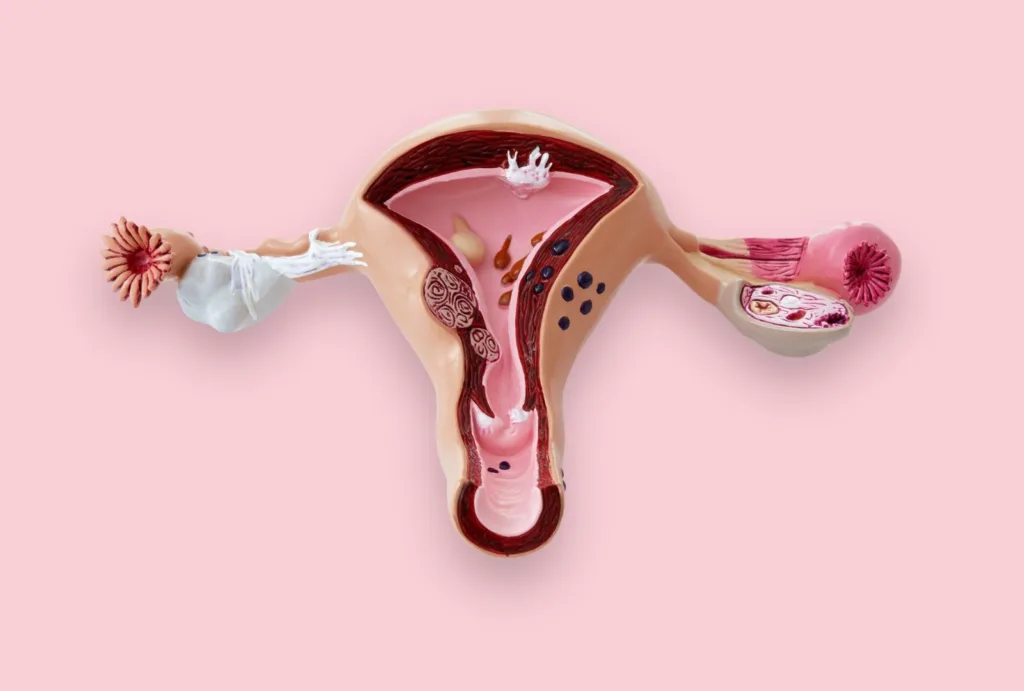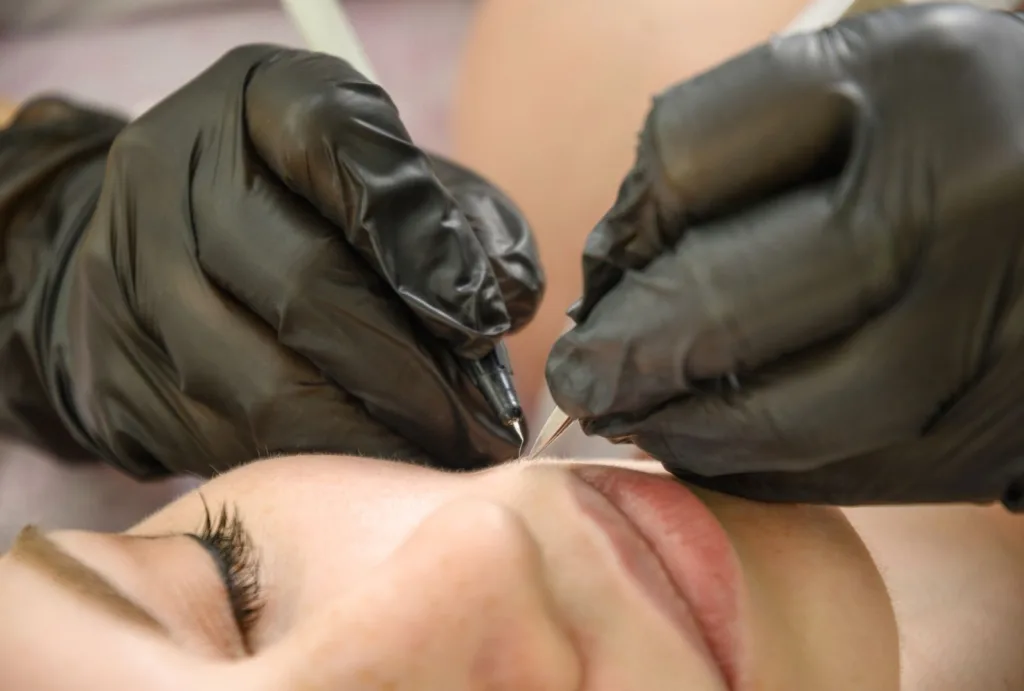
Have you ever found yourself in front of the mirror, tweezers in hand, waging war against those pesky, unwanted hairs that seem to have a life of their own? You’re not alone! For many, this is just a part of their daily beauty routine, but for some, it’s a constant reminder of a deeper battle with Polycystic Ovary Syndrome (PCOS). It’s more than just the physical symptoms; it’s a condition that can play hide and seek with your hormones and metabolism, leading to a host of issues, including that unwelcome hair growth.
So, what’s the deal with PCOS and hair sprouting in places you wish it wouldn’t? In a nutshell, PCOS often leads to a hormonal rollercoaster with testosterone levels riding a bit higher than the norm, and where there’s testosterone, there can be hair—lots of it, and often in areas where women typically have little to none. It’s like your body decided to throw a hair party without your permission!
Is it starting to click? Maybe you’ve seen these signs in yourself or someone close to you, and it’s got you wondering, “Is there a way to show these hairs the exit once and for all?” Enter electrolysis—a knight in shining armor for many in this hairy predicament.
Let’s pause for a sec. Are we good to keep diving deeper into the nitty-gritty of PCOS before we zap into the world of electrolysis? Or is there something specific on your mind that you’re itching to get to first?
Understanding PCOS

What’s Going On Inside: The Science Behind PCOS
Ever wonder what’s happening in your body when PCOS is at the helm? Imagine a bunch of hormonal levers and dials being turned in all the wrong directions. PCOS is essentially a hormonal imbalance where the ovaries produce more androgens (male hormones) than usual, which can interfere with the development and release of eggs. Ovaries might even take a little nap and not ovulate at all. And when ovulation goes on a break, it can lead to irregular periods and those tiny, pesky cysts the condition is named after.
Symptoms and Signs: Recognizing the Indicators of PCOS
Spotting PCOS isn’t as easy as finding a needle in a haystack; sometimes, it’s more like finding a specific piece of hay in a haystack. Symptoms can vary widely, but here are a few common ones that might ring a bell:
- Irregular periods: Like a friend who never shows up on time, your menstrual cycle can become unpredictable.
- Excess hair growth: We’re talking about hair on your face, chest, back – areas where it’s not usually welcomed.
- Acne or oily skin: Because who doesn’t want a flashback to their teenage years?
- Weight gain: When you’ve been eating healthy but your body didn’t get the memo.
- Thinning hair on the head: Yes, hair grows where you don’t want it and decides to bail where you do. Oh, the irony!
- Fertility issues: Because the ovaries are playing hard to get (quite literally).
Does this list have you nodding along? If so, you might be dealing with PCOS. But don’t worry, it’s more common than you think, and there are ways to manage it.
The Emotional Toll of PCOS

More Than Just Physical: The Psychological Impact of PCOS
It’s not just a few unwanted hairs or irregular periods—PCOS can feel like an uninvited guest that affects every party of your life. It can be emotionally draining, and let’s be real, downright infuriating. The constant battle with weight, the acne that no fancy cream seems to fix, the fertility fears—it can all take a toll on your mental health. It’s like your body is throwing curveballs at your self-esteem.
Shared Experiences: You’re Not Alone in This
But here’s a little secret: you’ve got a squad you didn’t even know about. Millions of women are riding the same hormonal wave, each with their own PCOS story. And when you start sharing and listening, you realize there’s strength in numbers. Ever joined a PCOS support group? It’s like a hive of warrior queens who get it, because they live it. It’s not just comforting; it’s empowering to know you’re part of a community that’s got your back.
So, when you’re feeling down, remember: you’re part of a fierce tribe. And there’s something incredibly powerful about finding your people and knowing that they understand the challenges you face—no explanation needed.
Electrolysis
The Hairy Details
Zapping Away the Trouble: What is Electrolysis?
Now, let’s switch gears and talk about a solution to one of the most visible symptoms of PCOS: unwanted hair. Electrolysis is not just your average hair removal method; it’s the only FDA-approved permanent hair removal technique. How does it work? Imagine a tiny lightning bolt zapping away each individual hair follicle. It’s a precision game where a skilled electrologist inserts a fine probe into the hair follicle and delivers an electric current to nix the hair growth at its root. Sounds like a sci-fi movie, right? But it’s a real-deal solution for many.
Is it Safe?: Debunking Myths About Electrolysis
When you think about electricity meeting your skin, it’s normal to raise an eyebrow (hopefully not the one you’re treating). But let’s bust some myths: electrolysis is safe when performed by a licensed professional. It’s been around since the 19th century—talk about standing the test of time! And while the idea of “permanent” can sound as elusive as a unicorn, with electrolysis, it’s actually grounded in reality.
Preparing for Electrolysis
Getting Ready: Steps to Take Before Your Appointment
Getting ready for electrolysis is a bit like preparing for a first date. You want to make sure everything goes smoothly, and that means doing your homework. Here are some steps to help you prepare for your appointment:
- Research: Look for a licensed electrologist with great reviews. This isn’t the time to skimp or take chances.
- Consultation: Many electrologists offer free consultations. Take advantage of this to get to know them, ask questions, and understand their process.
- Skin Prep: Avoid tanning and don’t pluck or wax! Shaving is fine; the electrologist just needs to see a few days’ worth of growth to identify the hairs that need to go.
- Hydration: Drink plenty of water the day before. Hydrated skin improves the effectiveness of electrolysis and can help with healing.
- Pain Management: If you’re worried about discomfort, you can talk to your electrologist about topical anesthetics.
What to Expect: The Electrolysis Process Explained
When D-Day arrives, you’ll want to know what to expect. You’ll be in a comfy chair, and the electrologist will use a magnifying glass or a microscope to get up close and personal with your unwanted hairs. They’ll insert a tiny probe into the hair follicle, zap it with an electric current, and then gently remove the hair with tweezers. It’s a bit of a tedious process, but think about the long-term freedom!
The Procedure

In the Hot Seat: What Happens During Electrolysis
Alright, you’ve done the legwork, you’re prepped, and now you’re sitting in the chair, about to get down to the nitty-gritty. Here’s what you can expect:
- Clean Slate: Your electrologist will cleanse the area to keep everything hygienic.
- Tiny Tweaks: They’ll adjust their equipment to suit your hair type and skin.
- The Zap: One by one, each hair gets its own personal goodbye, with a quick zap from the probe.
- Tweeze and Repeat: After the zap, the hair is removed with tweezers, and it’s on to the next one!
Managing the Ouch: Tips for Pain Management
Let’s be honest—no one loves the idea of a tiny zap. But there are ways to manage any discomfort:
- Breathe: Good old-fashioned deep breathing can do wonders.
- Distraction: Chat with your electrologist or listen to some music.
- Aftercare: A soothing cream or cold compress post-session can be a relief.
It might sound a bit daunting, but remember, it’s a journey toward permanent hair removal. Each session leaves you with fewer hairs to worry about, and that’s a comforting thought.
Aftercare and Results
The Aftermath: Taking Care of Your Skin Post-Electrolysis
You’ve braved the zaps and are now on the other side. But before you strut out feeling like a hairless cat, let’s make sure you know how to take care of that treated area. Aftercare is crucial to avoid any irritation or infection and to ensure the best possible results. Here’s what you need to do:
- Keep it Clean: Gently cleanse the area with mild soap and water.
- Stay Cool: Apply a cold compress if you experience any swelling or discomfort.
- Soothe It: Use a calming aloe vera gel or any aftercare product recommended by your electrologist.
- Avoid the Sun: Keep the treated area out of the sun to prevent hyperpigmentation.
- Resist Touching: As tempting as it might be, don’t pick or scratch the area.
Patience is Key: Realistic Expectations on Results
Now, don’t expect to walk out completely hair-free after your first session. Electrolysis is a bit like chipping away at a sculpture—it takes time to reveal the masterpiece. You’ll likely need several sessions, as hair grows in different stages and all follicles aren’t active at the same time.
After a series of treatments, you’ll start to notice significant hair reduction, and eventually, the joy of permanent hairlessness in the treated areas. So, patience is not just a virtue; it’s a key player in the electrolysis game.
Managing PCOS Beyond Hair Removal
Holistic Approach: Lifestyle Changes to Manage PCOS
Electrolysis tackles the hair issue, but managing PCOS as a whole requires a broader strategy. Think of it as a lifestyle makeover. Here’s what you can do to keep PCOS in check:
- Diet: Focus on a balanced diet. Some find that a low-GI diet helps manage symptoms.
- Exercise: Regular physical activity can improve insulin sensitivity and help with weight management.
- Stress Reduction: Yoga, meditation, or just deep-breathing exercises can keep stress hormones at bay.
- Sleep Well: Never underestimate the power of a good night’s sleep on your hormonal balance.
Medical Interventions: When to Consider Medication or Surgery
While lifestyle changes are the frontline defense, sometimes you need extra help. This is where medical interventions come in:
- Medications: From birth control pills to regulate periods to medications like metformin for insulin resistance, there are options available.
- Surgery: In some cases, a surgical procedure known as ovarian drilling is performed to induce ovulation.
Each individual’s journey with PCOS is unique, and what works for one person may not work for another. It’s about finding the right balance for your body and lifestyle.
Final Words
Managing PCOS is a marathon, not a sprint. Whether you’re dealing with unwanted hair through electrolysis or tackling other symptoms, remember that you’re in control. With every step, you’re learning more about your body and how to live harmoniously with PCOS.
Now that we’ve walked through the ins and outs of PCOS and the wonders of electrolysis, we’d love to hear from you. Have you tried electrolysis? What lifestyle changes have made a difference for you? Sharing your story can inspire others and build a community of support. So, don’t be shy—let’s continue the conversation.




